中国古典乐器—古筝琵琶英文介绍(带翻译)精讲
- 格式:ppt
- 大小:4.17 MB
- 文档页数:15
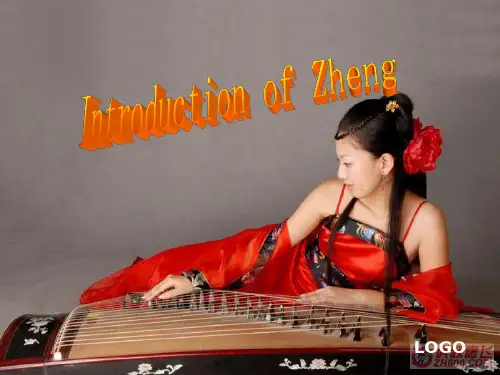
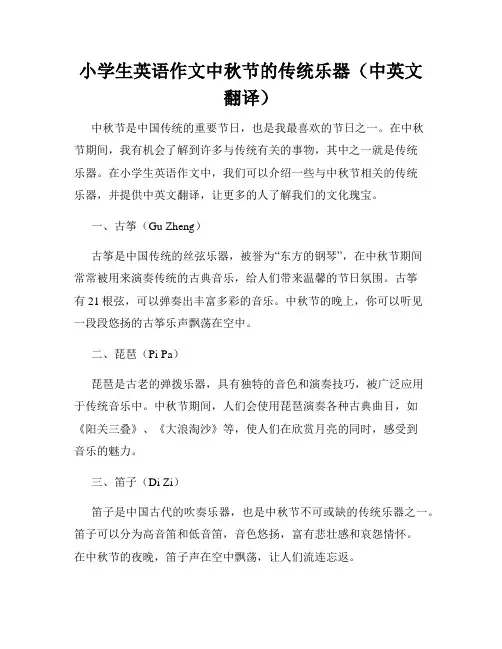
小学生英语作文中秋节的传统乐器(中英文翻译)中秋节是中国传统的重要节日,也是我最喜欢的节日之一。
在中秋节期间,我有机会了解到许多与传统有关的事物,其中之一就是传统乐器。
在小学生英语作文中,我们可以介绍一些与中秋节相关的传统乐器,并提供中英文翻译,让更多的人了解我们的文化瑰宝。
一、古筝(Gu Zheng)古筝是中国传统的丝弦乐器,被誉为“东方的钢琴”,在中秋节期间常常被用来演奏传统的古典音乐,给人们带来温馨的节日氛围。
古筝有21根弦,可以弹奏出丰富多彩的音乐。
中秋节的晚上,你可以听见一段段悠扬的古筝乐声飘荡在空中。
二、琵琶(Pi Pa)琵琶是古老的弹拨乐器,具有独特的音色和演奏技巧,被广泛应用于传统音乐中。
中秋节期间,人们会使用琵琶演奏各种古典曲目,如《阳关三叠》、《大浪淘沙》等,使人们在欣赏月亮的同时,感受到音乐的魅力。
三、笛子(Di Zi)笛子是中国古代的吹奏乐器,也是中秋节不可或缺的传统乐器之一。
笛子可以分为高音笛和低音笛,音色悠扬,富有悲壮感和哀怨情怀。
在中秋节的夜晚,笛子声在空中飘荡,让人们流连忘返。
四、扬琴(Yang Qin)扬琴是中国古代的击弦乐器,可以用指尖弹奏出丰富的乐音。
扬琴非常适合演奏中秋节期间的歌曲和民间舞蹈音乐,如《月光光》、《天涯歌女》等。
通过扬琴演奏,人们可以感受到节日的喜庆和欢乐。
五、二胡(Er Hu)二胡是流行于中国北方的拉弦乐器,以其独特的音色和悲壮的演奏效果而闻名于世。
在中秋节期间,二胡常常用来演奏一些古老的民间曲目,如《二泉映月》等,让人们在中秋月光下陶醉于音乐的海洋中。
通过介绍这些传统乐器,我们可以更好地了解中秋节的文化内涵,并且向外国朋友展示我们的音乐艺术。
希望在小学生英语作文中,能够多多提及这些乐器,让更多的人了解和喜爱中国传统音乐。
In English Translation:The Traditional Musical Instruments of the Mid-Autumn Festival in Primary School Students' English CompositionsThe Mid-Autumn Festival is a traditional and important festival in China, and it is also one of my favorite festivals. During the Mid-Autumn Festival, I have the opportunity to learn about many traditional things, one of which is traditional musical instruments. In primary school students' English compositions, we can introduce some traditional musical instruments related to the Mid-Autumn Festival and provide translations in both Chinese and English to let more people know about our cultural treasures.1. Gu ZhengGu Zheng is a traditional Chinese plucked string instrument, known as the "Piano of the East". It is often used to play traditional classical music during the Mid-Autumn Festival, creating a warm festive atmosphere. Gu Zheng has 21 strings, and it can produce a rich variety of music. On the night of the Mid-Autumn Festival, you can hear the melodious sound of Gu Zheng drifting in the air.2. Pi PaPi Pa is an ancient plucked musical instrument with unique tones and playing techniques. It is widely used in traditional music. During the Mid-Autumn Festival, people use Pi Pa to perform various classical pieces, such as "The Three Repeats at Yangguan" and "Waves Washing the Sand", allowing people to appreciate the charm of music while enjoying the moon.3. Di ZiDi Zi is a Chinese ancient flute, an indispensable traditional instrument during the Mid-Autumn Festival. Di Zi can be divided into high-pitched and low-pitched flutes, with a melodious and mournful tone. On the night of the Mid-Autumn Festival, the sound of Di Zi lingers in the air, making people linger.4. Yang QinYang Qin is a Chinese ancient plucked instrument that can produce rich musical sounds by plucking the strings with fingertips. Yang Qin is very suitable for playing songs and folk dance music during the Mid-Autumn Festival, such as "Moonlight" and "Songstress of Tianya". Through theperformance of Yang Qin, people can feel the joy and happiness of the festival.5. Er HuEr Hu is a bowed string instrument popular in northern China, famous for its unique tone and tragic performance effect. During the Mid-Autumn Festival, Er Hu is often used to perform some ancient folk tunes, such as "Moon Reflected on Second Spring" and so on, allowing people to immerse themselves in the ocean of music under the moonlight.By introducing these traditional musical instruments, we can have a better understanding of the cultural connotation of the Mid-Autumn Festival and showcase our music art to foreign friends. It is hoped that in the English compositions of primary school students, we can mention these instruments more, so that more people can understand and love traditional Chinese music.。

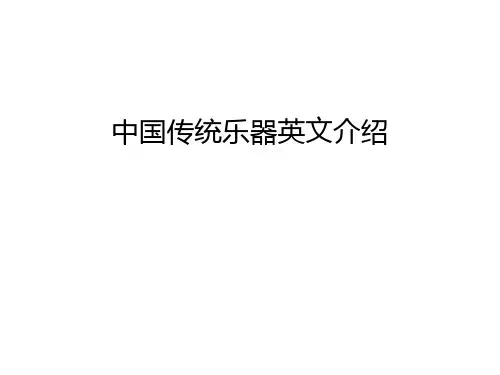
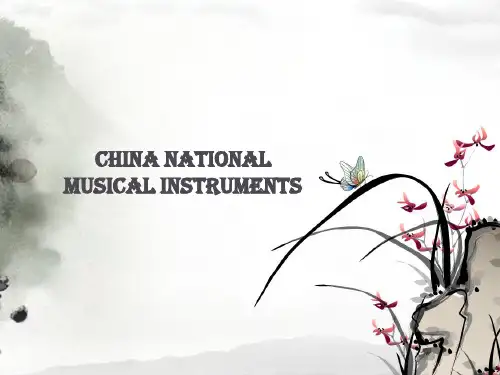
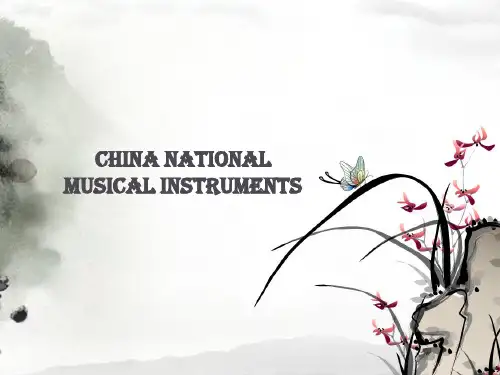
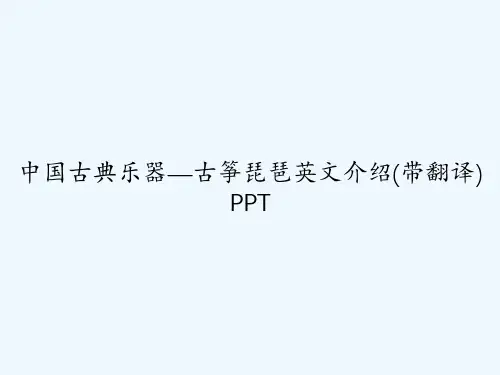

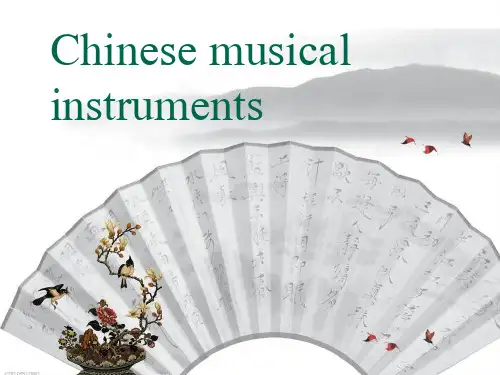
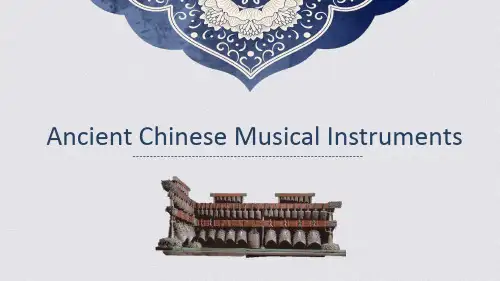
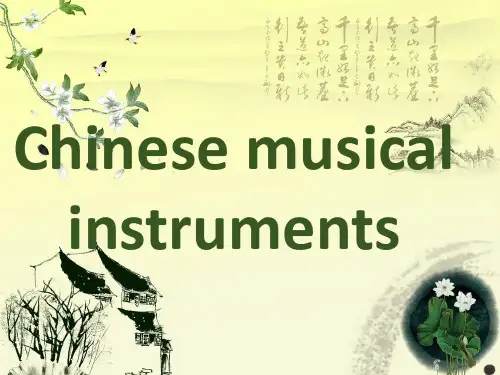
古琴:Qin, also known as Yao Qin, Yu-Qin, a lyre, for the Chinese one of the oldest plucked instruments, the qin is already prevalent in the Confucian period instruments, there are words to consider the history of thousand years, according to "Historical Records" contains, The emergence of Qin period no later than Yao and Shun. The beginning of this century, only for the distinction of Western instruments in the "piano" added in front of a word "historic", called "Qin." Still ringing in his study so far, the ancient musical instruments on stage.巴乌Bau, is a bamboo reed instruments copper, spring for the tongue. The Yi, Hani, Dai, Wa, Blang, Miao and other ethnic wind instruments. Yi called the local "and Fei Limo", Hani called "Meiba." Bau is popular in southwest China Yi, Miao, Hani and other single-reed wind instrument family, Bau is made with bamboo, has eight finger holes (seven before the latter), disposed in the mouthpiece of a brass reed tongue tip, blowing across the top of playing, vibrating reed sound. Bau smallervolume, but the sound soft, southwest China's people call it a talking instrument. Bau popular in the Red River in Yunnan Province, Wenshan, Simao, Xishuangbanna, Lincang, Dehong, meltwater Guangxi Zhuang Autonomous Region, Guizhou Province, Guizhou and South Guizhou and other places.Dizi (笛子): The dizi is a bamboo flute.It has been suggested thatthe instrument originated in Southern orCentral Asia over 2000 yearsago. It is a unique solo instrument and isalso used extensively inensembles and orchestras. These flutes have 6open holes and a lovelybright sound.笛子是由竹子做成的乐器,据说在2000年前最早出现于南亚和中亚。
琵琶的英文介绍作文英文:As a musical instrument, the pipa is a traditional Chinese plucked string instrument that has a history of over 2000 years. It has a pear-shaped body with fourstrings that are attached to the instrument's head and stretched over the fretboard. The pipa is played by plucking the strings with the right hand while pressing the frets with the left hand to change the pitch.The pipa has a unique sound that is both bright and crisp, making it a popular instrument in traditional Chinese music. It is also a versatile instrument that can be played solo or as part of an ensemble.As someone who has played the pipa for many years, I can attest to its beauty and complexity. Learning to play the pipa requires discipline and dedication, but the rewards are well worth it. When playing the pipa, I feel asense of connection to my cultural heritage and a deep appreciation for the art of music.中文:作为一种乐器,琵琶是一种有着2000多年历史的中国传统弹拨弦乐器。
介绍中国乐器琵琶英语作文The Chinese Musical Instrument Pipa。
The pipa is a traditional Chinese musical instrumentwith a history that dates back over 2,000 years. It is afour-stringed lute with a pear-shaped body and a short neck. The pipa is played by plucking the strings with the fingers, and it produces a beautiful and melodious sound that isoften described as being both elegant and haunting.The pipa has a long and rich history in Chinese culture, and it has been an important part of traditional Chinese music for centuries. It is often featured in traditional Chinese opera, as well as in solo and ensemble performances. The pipa has also been used in a wide range of musical styles, including classical, folk, and contemporary music.The pipa is known for its versatility and expressive range. It can produce a wide variety of sounds, from soft and delicate to powerful and dynamic. The instrument iscapable of expressing a wide range of emotions, and it is often used to convey feelings of joy, sorrow, love, and longing.In addition to its musical capabilities, the pipa is also valued for its cultural significance. It is often associated with traditional Chinese values such as grace, elegance, and refinement. The instrument is also deeply rooted in Chinese history and mythology, and it is often featured in traditional Chinese art and literature.The pipa has also gained popularity outside of China, and it has been embraced by musicians and audiences around the world. In recent years, the instrument has been featured in a wide range of international music festivals and performances, and it has been praised for its unique and captivating sound.In conclusion, the pipa is a truly remarkable musical instrument with a long and storied history. It has played a central role in traditional Chinese music for centuries, and it continues to be cherished for its beauty,versatility, and cultural significance. As the pipa continues to gain recognition and popularity around the world, it is clear that its enchanting sound will continue to captivate audiences for generations to come.。
Hello,everyone.Our group's speech theme is the Chinese classical musical instrument.These are instruments that we each have to say.My name is HeLingjie,and I will introduce to you Zheng.The music you listening is "water lilies".简介Brief introductionThe Zheng ,a pluked zither,is one of the most important instruments in Ancient China musics.筝,一种带雁柱的琴,是古代中国音乐中最重要的乐器之一。
Its 21 strings stretch lengthwise across the body like a box.Under each string is a separate, movable bridge.Zheng is tuned by changing the position of the bridges.Because it can change the tension of the strings.To play the Zheng need to put on false nails on both hands.它的21根琴弦张在如同空木盒子一般的琴身上。
在每一弦下支着一个可以移动的雁柱。
筝是以改变琴弦下雁柱的位置来定调的。
因为这样做可以改变琴弦的张紧程度。
筝的演奏需要双手带上假指甲。
起源OriginAs early as 2500 years ago in the warring states period,zheng are widely spread in at the time of the Qin (now Shaanxi) area, also known as qinzheng.早在2500年前的战国时期,筝就在当时的秦国(现陕西)一带广泛流传,又名秦筝。